 Romanesque church of St Caecilia, Cologne. Now the Schnuetgen Museum of Medieval Art Romanesque church of St Caecilia, Cologne. Now the Schnuetgen Museum of Medieval Art ermany has a tradition of carved religious statuary unbroken from the early middle ages, so was not surprised that this art form dominated the lovely Schuetgen Museum in Cologne: it is a private collection, donated to the city, and perfectly housed in Romanesque church building. I had the place almost to myself, and could walk round all the exhibits and examine them from near and far to my heart's content, only slightly inhibited by the hovering of the museum guardian who, having no one else to keep an eye on, and presumably having long since exhausted the novelty of the exhibits, trailed me round like my own personal minder. I remarked hintfully that he must find the work very dull but he shrugged and said, "Ein Job ist ein Job". Looking over the photographs I took, I feel provoked to get on the soapbox for one of my rants. Will somebody please tell me how in the world we got from this:- A 12th C carved wooden corpus (polychrome, but paint now eroded) in Schnuetgen Museum Cologne. - to this? - And this? The local talentPeople, have we all gone blind? Is this a proper focus for prayer and meditation? Why are we confronted every Sunday by this kind of ubiquitous glassy-eyed tat? Is it because The Committee would rather buy something out of a supplier's catalogue than risk dealing with a real live artist? There are people who make a living out of restoring these plaster statues - it shouldn't be allowed! When I am dictator of the world we will consign all the hideous pious paraphernalia to the cemetery and commssion some real artists. Even if it's not world class it will surely be more honest and expressive than what we've got now. There is a Facebook Group entitled "I'm fed up with bad church music". I propose a sister act entitled "We're sick of tacky church art", I have worked myself up into such a passion now that I can only append, without further invidious comparison, a sample of the other magnificent Christian art on display at the Schnutgen Museum.
Recently a family member asked me to provide some artwork for the cover of a forthcoming book, which besides being my first opportunity at a project of this kind presented some interesting technical problems. Gold areas in a design are notoriously difficult to reproduce in print. Every scratch and blemish is magnified in a scan, it comes out looking dull and brown, or gives off unwanted reflections. I decided it would be a waste to include any gold in the design at all. Not that lack cheapens the piece as an icon in any way. In the past, icon painters by no means always used gold in their designs. In times of scarcity or of war, for fresco schemes, for clients with shallower pockets, or sometimes simply for artistic reasons, many icons were painted with coloured backgrounds. Putting aside its symbolical properties, burnished gold acts as neutral in a painting (strangely enough) and also, as a background, makes a motif 'tell up' incredibly well. Also, let's be honest, that amount of bling tends to distract from a multitude of shortcomings in a painting. Icon painters can tend to get very hung up on the quality of their gilding and devote less time to improving the actual painting!
In the end I substituted a painted ground of red for the the medallion of Christ. I added the symbols of the four gospellers afterwards, to complete the piece as an icon, and used brilliant white for the background. White is used in icons to convey the brilliance of uncreated light (think of Christ's robes in icons of the Transfiguration). I would have made life a great deal easier for myself if I had not glazed the red with transparent quinacridone pigment to warm its tone - forgetting that quinacridone is horribly staining and travels everywhere, especially onto pure white backgrounds! The quinacridones are a new addition to the artist's palette, developed by the car industry I am told, and useful as a substitute for carmine and alizarin, which are of suspect lightfastness. It's just too darn messy, though; I think I shall have to retire it from my arsenal. An icon of Christ the Teacher in combination with the Hindu and Buddhist lotus symbol were specifically requested by the author to tie in with the theme of the book, which is a work of comparative theology. I designed the roundel of Christ to appear within the 'O' of the book title, with the eastern lotus symbol and frieze beneath, though no doubt the publisher will rehash my design to his own taste. I believe the book goes to print quite shortly: publisher James Clarke & Co Ltd. The actual icon will be framed (unusual for me, but for purposes of reproduction the board was a lightweight one), and appear for sale on my website in due course.  As a child visiting my grandparents, I used to love poring over their twelve volumes of Arthur Mee's Children's Encyclopedia. A wonderful work, in print for an incredible sixty years from the early 1900s! Among the many anachronistic treasures to be found therein were photographs of the great North European cathedrals taken before the terrible destruction visited on so many of them during the second world war. I had them in mind on my recent visit to Cologne in Germany, home of the famous Koelnisch Wasser ('4711' as it's known - my grandmother had a covetably dinky little bottle of it sitting on her dressing table). Cologne, always important for its strategic trading position on the Rhine, is now a modernised industrial city famous for its crazy Easter carnival which lasts six months and for having being bombed to blazes during the war. But happily there are some surviving golden nuggets for the medieval art enthusiast to mine. Most well-known of them is the cathedral, whose blackened twin towers rise into the sky as a testament to the Koelner tenacity and determination to rebuild it from the ruins. The citizens set about the task of rebuilding almost immediately after the war, and work continues to this day. The cathedral houses a magnificent golden shrine to the Magi whose reputed mortal remains have been here since the early twelfth century. I wish I could have got closer to the reliquary, because it is an artwork almost worthy of reverence in itself, made by the incomparable medieval goldsmith Nicholas of Verdun. Instead I lit a candle for a precious family friend whose death we heard of while we were away, and thought of the beautiful Poulenc motet he and I used to sing in the church choir, 'Videntes stellam': teeth-jarringly beautiful dissonances in the second soprano line. "Seeing the star, the wise men were overwhelmed with great joy;and entering the dwelling, they offered to the Lord gold, frankincense, and myrrh. The day of my visit a great deal of noisy pavement construction was going on, and the ambulatory was occupied by a mini-crane with a woman bravely perched thirty or forty feet up in the bucket, dusting a polychrome archbishop with paint brush and vacuum. She noticed me taking the photograph and shot me an old-fashioned look, which is my excuse for the lack of focus. Unfortunately most of my pictures of the interior were either too blurred or too dark to be worth publishing. The second photo below was intended to show the interesting painted gothic beam, looking as if it were originally part of a rood screen - but instead the modern mosaics below the clerestory show up much better. The third grainy photo is of a painted stone side altar which caught my eye, partly for the green and red colour interchange which I love so much and seems so characteristic of gothic art. Also in Cologne I found the Schnuetgen Museum, a cave of medieval treasures - more to follow soon!
Gold is yellow, right? Well not really: some golds are more yellow than others. The two icons of St Francis above are looking like one of those 'spot the difference' puzzles we used to get as children, but the chief difference - the colour of the gold leaf I used in each - is not at all obvious on the screen. When you go to buy a book of gold leaf - generally from an on-line supplier - the array of golds on offer is completely bewildering. Bog standard 'yellow' gold can be 24, 23 or 22 carat, extra thick, double thick or regular, and each differs slightly in its tone. Not enough difference to read on a computer screen perhaps, but very obvious if you accidentally mix them up on the same painting (yep, been there!). Then there's Italian gold, German ducate, moon gold, red gold, lemon gold, green gold, champagne gold, white gold - the computer screen doesn't give one a very good idea of the differences and sample books are very expensive. The different colours are determined by the quantity and type of alloy metals in the leaf - silver, copper, nickel etc. 24ct gold, being pure, is a rich yellow colour; 22ct tends to be slightly more silvery. Some gold leaf has more of a crinkly texture, which you may or may not like. The presence of copper in the mix makes the leaf appear pinker (one sees this reddier tone clearly in gold jewellery made in India, for example).
So how to choose? Well, anything below 22ct is likely to tarnish fairly quickly, so is best avoided for work that you want to last: that instantly eliminates quite a number of options offered by the goldbeater. 24ct gold is more malleable and does not tarnish at all, so is chosen for 'best work' and for anything that will be exposed to the outside air. It is softer and therefore show the joins between leaves less after burnishing. Using 'double' or 'extra thick' gold leaf may mean you can avoid double gilding, which is generally necessary in order to get a good finish with standard thickness leaf: it is more expensive than standard thickness, so you will have to calculate whether with luck and skill you will make a saving or end up having to double gild anyway! For work intended to stay indoors, so less exposed to atmospheric pollution, 22 ct is adequate and perhaps a little easier to handle on the cutting pad. Beyond those parameters, you can let your choice be dictated by personal taste and price. The second of my St Francis icons (dated 2017) was made with 23 ct red gold, which I bought this time for no better reason than that it was older stock being offered at the old price. I like the way its warmer tone sits with the reds and browns of the icon - I have yet to decide whether it will sit comfortably in other pieces. |
The view from my deskCurrent work, places and events, art travel, and interesting snippets about Christian icons, medieval art, manuscript illumination, egg tempera,, gilding, technique and materials. Categories
All
Archives
January 2024
|

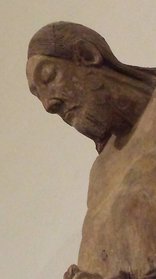
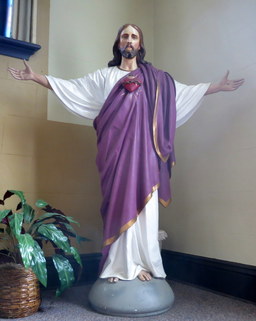










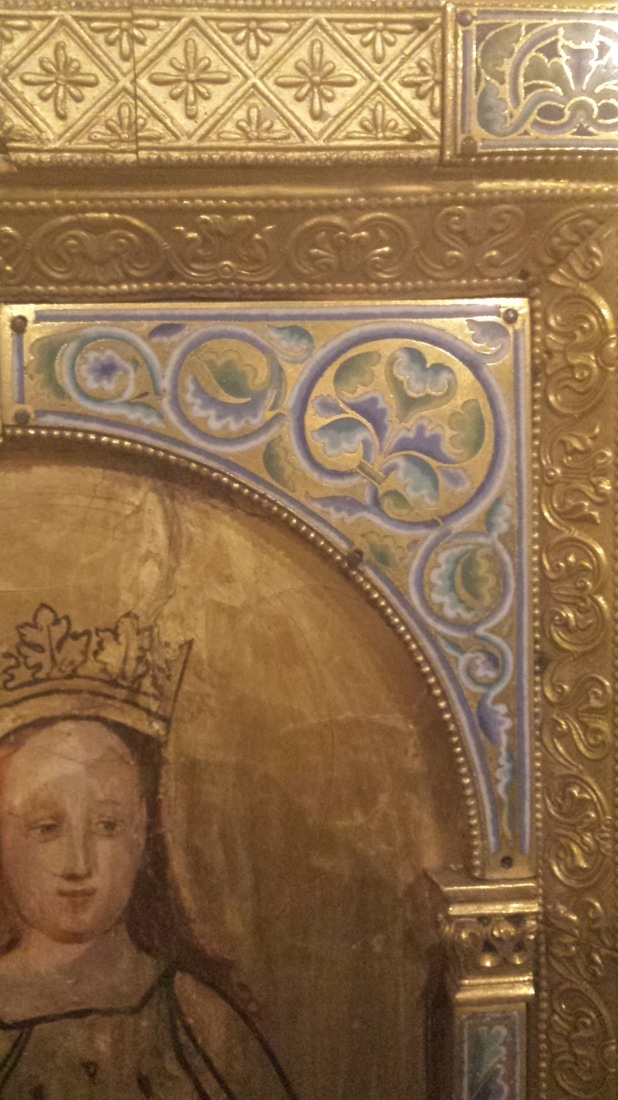


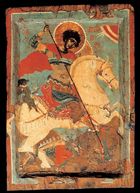






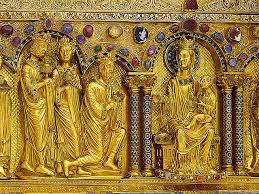




 RSS Feed
RSS Feed